Wireless Remote control Crane, Wireless Crane Controller & Control System
Wireless Remote control Crane,Wireless Crane Controller & Control System
Wireless remote control crane for sale. Custom wireless remote control overhead crane, gantry crane, jib cranes for your particular needs.Get your crane design!
In the field of material hanlding, the technological advancements have revolutionized the way cranes operate, ushering in an era of enhanced efficiency and safety. Among these innovations, Wireless Remote Control Crane systems have emerged as a pivotal evolution in crane operations.
Wireless Crane Control Systems represent a paradigm shift from traditional crane control mechanisms. They utilize cutting-edge wireless technology, enabling operators to remotely maneuver cranes without the constraints of physical wiring or tethered controls. This wireless approach facilitates increased flexibility, mobility, and precision in crane operations.
The evolution of wireless technology within the realm of crane operations has been profound. From manual controls to wired remote systems, the transition to wireless control has significantly augmented the efficiency and safety standards of crane functionalities. The evolution reflects a commitment to optimizing operations while prioritizing operator safety.
The significance of Wireless Control in crane operations cannot be overstated. This technology has redefined the operational landscape by enhancing crane maneuverability, providing improved access to hard-to-reach areas, and enabling swift response times. Moreover, it plays a pivotal role in bolstering safety protocols by minimizing potential hazards associated with wired controls and offering better ergonomics for operators.
Exploring Different Types of Wireless Remote Control Cranes
Wireless Remote Control Cranes encompass a diverse array of crane types engineered to cater to various industrial lifting needs. These cranes are classified based on multiple factors such as their structural design, lifting mechanisms, below-hook devices, and intended industrial applications. Common types of Wireless Remote Control Cranes include single girder cranes, double girder cranes, top running and under running cranes, wall-mounted cranes, semi goliath cranes, portable gantry cranes, and more. Each type offers distinct features, benefits, and applications tailored to specific lifting requirements in industries ranging from manufacturing, automotive, construction, logistics, and shipbuilding. These cranes are equipped with Remote Wireless control technology, enhancing their efficiency, safety, and maneuverability in various industrial settings.
Wireless Remote Control Crane
Overhead Remote Wireless cranes stand as a pinnacle of industrial lifting equipment, revolutionizing traditional material handling operations. These cranes, designed for various industrial applications, elevate efficiency, safety, and flexibility by integrating Remote Wireless control technology into their functionality.
Overhead Remote Wireless cranes are a class of lifting machinery equipped with cutting-edge Remote Wireless control capabilities. These advanced systems allow operators to manipulate crane movements, load handling, and positioning from a safe distance, enhancing operational efficiency and safety within industrial settings.
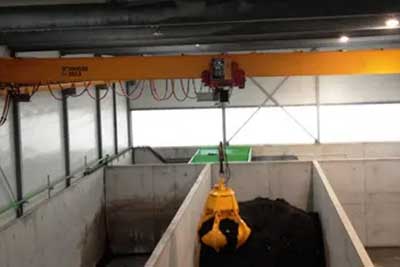
Single Girder Cranes
Features: Single bridge girder supporting the hoist and trolley, cost-effective.
Benefits: Cost efficiency, ideal for moderate lifting tasks.
Typical Applications: Workshops, warehouses, and manufacturing units.
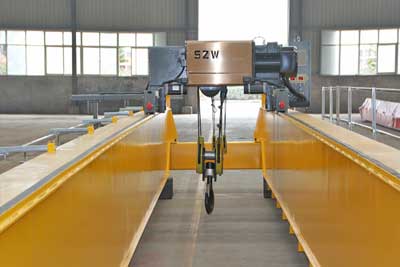
Double Girder Cranes
Features: Equipped with two girders for enhanced stability and higher lifting capacities.
Benefits: Increased stability, precision in heavy-duty lifting.
Typical Applications: Steel mills, foundries, shipyards.

Under Running Cranes
Features: the under running crane travels beneath the crane runway.
Benefits: Under running for space-saving.
Typical Applications: The under running for limited space areas.
Key Features and Functionalities:
Remote Wireless Operation: A defining feature that enables operators to control the crane's movements, including hoisting, lowering, and traversing, using Remote Wireless control devices.
Enhanced Safety: Remote Wireless control technology reduces the need for direct operator proximity to the load, minimizing potential risks and hazards associated with manual operation.
Efficiency and Precision: The precise control afforded by Remote Wireless operation enhances load handling, offering increased accuracy and speed in material transportation.
Versatility: These cranes are adaptable to various work environments, allowing for flexible and efficient material handling across industries.
Overhead Remote Wireless cranes find diverse applications across industries such as manufacturing, construction, logistics, warehouses, and more. Their ability to handle a wide range of loads, coupled with the flexibility and precision in operation, makes them indispensable tools in modern industrial settings.
With their ability to combine cutting-edge Remote Wireless control technology and robust lifting capacities, overhead Remote Wireless cranes stand at the forefront of industrial innovation, significantly enhancing productivity, safety, and operational efficiency in diverse work environments.
Remote Wireless Control Jib Cranes
Remote Wireless jib cranes represent a pinnacle in material handling solutions, offering versatile and efficient lifting capabilities within a controlled workspace. These cranes, equipped with Remote Wireless control technology, provide an optimal blend of maneuverability, precision, and safety, making them integral in various industrial operations.
Remote Wireless jib cranes, a subset of lifting equipment, feature a horizontal jib or boom assembly mounted onto a vertical mast. The distinguishing factor lies in their Remote Wireless control capabilities, enabling operators to manage lifting operations from a distance. This innovation has redefined material handling processes by allowing for precision and flexibility in load manipulation.
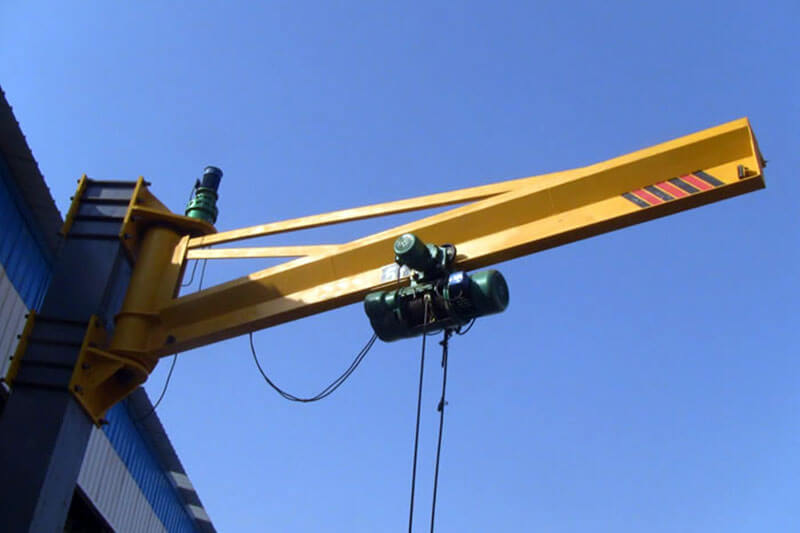
Wall-Mounted Remote Wireless Jib Crane:
Description: These jib cranes are affixed to a wall or column, providing a space-saving lifting solution.
Features: Fixed installation on a wall, offering 180 or 360-degree rotation for efficient load handling within a confined space.
Applications: Commonly used in smaller work areas, workshops, or production floors where floor space is limited.
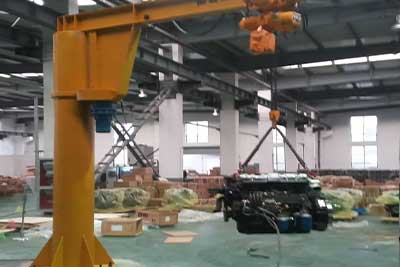
Floor-Mounted Remote Wireless Jib Crane:
Description: This type of jib crane stands on the floor and doesn't rely on a structure for support.
Features: Offers more mobility and flexibility in positioning compared to wall-mounted options.
Applications: Suitable for locations where wall or column mounting is impractical or not possible.
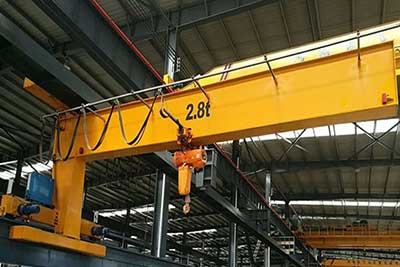
Wall-Traveling Remote Wireless Jib Crane:
Description: These cranes move horizontally along a wall-mounted track, combining the benefits of a wall-mounted crane with lateral movement.
Features: Allows the jib crane to travel along a fixed path on the wall, providing coverage across a larger area.
Applications: Commonly used in longer workspaces or facilities where a standard wall-mounted crane's reach is insufficient.
Each type of Remote Wireless jib crane serves distinct purposes, offering advantages in terms of space utilization, mobility, and load handling. Selection depends on the specific requirements of the workspace, including available area, load capacities, and the need for mobility or lateral movement.
Key Features and Functionalities:
Remote Wireless Control Operation: Remote Wireless jib cranes are characterized by their ability to control lifting, lowering, and horizontal movement via Remote Wireless devices or control panels.
Maneuverability: Their design facilitates easy movement of loads within a designated area, providing excellent reach and flexibility.
Safety Enhancements: Remote Wireless operation minimizes operator exposure to potentially hazardous environments, enhancing safety protocols.
Adaptability: These cranes are adaptable to various work settings, such as warehouses, workshops, and construction sites, due to their compact structure and efficient load-handling capabilities.
Remote Wireless jib cranes find applications across industries where lifting and handling of loads are routine. They are particularly useful in workshops, assembly lines, manufacturing units, and areas requiring localized lifting solutions. Their ability to efficiently handle moderate loads within a controlled space makes them an essential asset in industrial settings.
Remote Wireless jib cranes have transformed material handling operations by offering precision, safety, and versatility through Remote Wireless control technology. Their ability to enhance workplace efficiency, minimize risks, and adapt to various environments makes them indispensable tools across multiple industries.
Remote Wireless Control Gantry Crane
A Remote Wireless Control Gantry Crane represents a pivotal advancement in modern material handling technology, seamlessly merging the versatility of gantry cranes with the precision and convenience of Remote Wireless control operation. This innovative system allows operators to manipulate crane movements from a distance, enhancing both safety and efficiency in various industrial settings.
Utilizing advanced wireless technologies, Remote Wireless control gantry cranes have revolutionized the way heavy loads are lifted, transported, and positioned. These cranes are designed to cater to diverse industrial needs, offering flexible and precise handling solutions while reducing the need for manual intervention in material handling tasks.
Remote Wireless control gantry cranes are deployed across an array of industries such as manufacturing, construction, logistics, and more, proving instrumental in streamlining operations and optimizing productivity. Their adaptable nature and Remote Wireless operation capabilities make them an indispensable asset in workplaces where precision, safety, and efficiency are paramount.
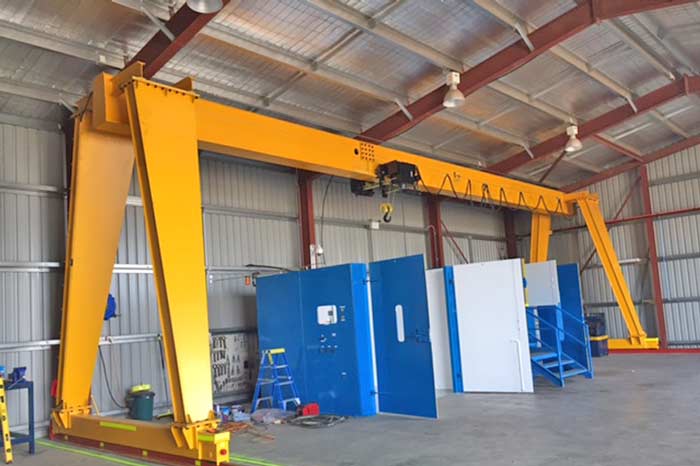
Remote Wireless Control Single Girder Gantry Crane:
Features:
Single girder configuration for efficient lifting and easy handling.
Well-suited for light to moderate load capacities.
Equipped with a Wireless Remote Control system for seamless operations.
Typical Applications:
Used in warehouses, workshops, and smaller manufacturing units.
Ideal for handling loads within a moderate weight range.
Suitable for tasks requiring precision and flexibility in lifting.
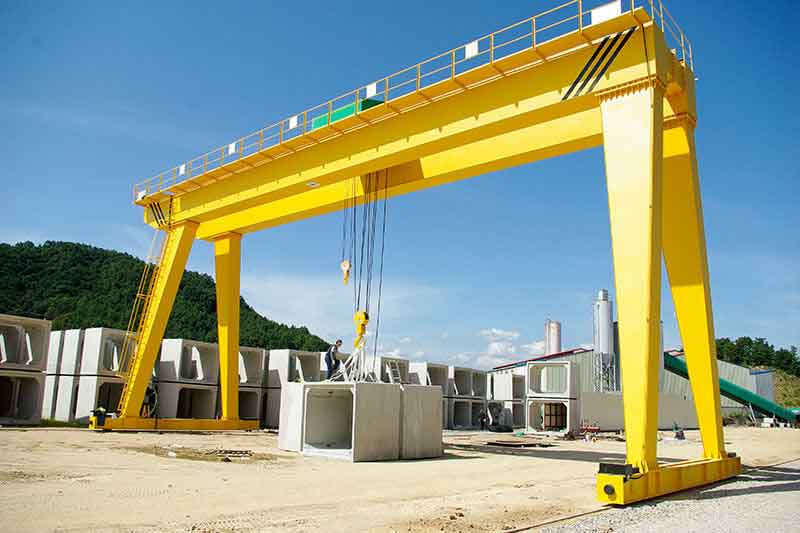
Remote Wireless Control Double Girder Gantry Crane:
Features:
Dual girder design for increased stability and higher lifting capacities.
Offers enhanced precision and efficiency in handling heavier loads.
Equipped with advanced Wireless Remote Control technology.
Typical Applications:
Widely used in heavy-duty industries like steel mills, foundries, and shipyards.
Ideal for handling bulkier and heavier materials with precision.
Suited for tasks demanding high lifting capacities and stability.

Remote Wireless Control Semi Gantry Crane:
Features:
One end travels on a runway while the other operates on the ground.
Combines the advantages of a gantry crane with partial mobility.
Integrated with a Remote Wireless control system for enhanced maneuverability.
Typical Applications:
Commonly used in outdoor environments like loading docks, construction sites, or varied terrain.
Suited for handling loads in semi-outdoor environments with varying terrains.
Offers flexibility in movement and operation, especially in restricted spaces.
Applications of Wireless Remote Control Crane
Manufacturing Industries:
Wireless crane control finds extensive usage in manufacturing units for lifting and transporting heavy components along assembly lines. The flexibility and precision offered by wireless systems enable efficient material handling and streamline production processes.
Construction Sites:
At construction sites, wireless crane control ensures precision in placing heavy materials and equipment. These systems enable operators to navigate and position loads accurately, enhancing safety and productivity on job sites.
Warehousing and Logistics:
In warehouse and logistics operations, wireless crane control systems optimize storage and retrieval processes. Operators can efficiently maneuver loads within limited spaces, improving inventory management and operational efficiency.
Shipbuilding Yards:
Shipbuilding yards utilize wireless crane control for the safe and efficient movement of ship components. These systems facilitate precise load handling, contributing to a safer working environment and expediting ship assembly.
Automotive Industry:
Wireless crane control systems play a crucial role in the automotive industry by aiding in the movement of vehicle parts during assembly. The accuracy and flexibility provided by wireless systems contribute to streamlined production workflows.
Steel and Metal Industries:
In steel and metal industries, wireless crane control ensures the precise handling of heavy metal components. These systems enable operators to handle materials with accuracy, minimizing the risk of damage.
Heavy Equipment Manufacturing:
Wireless crane control systems are utilized in the manufacturing of heavy equipment for the efficient handling of large and bulky machinery components. The ability to control crane movements remotely enhances safety and operational efficiency.
Wireless remote control crane systems offer adaptability across a diverse range of industries, contributing to improved safety standards, increased productivity, and enhanced operational efficiency in various industrial applications.
Wireless Remote Control Components and Functionality
Exploring the Wireless Crane Control Pendant: Features and Operations
The wireless crane control pendant is a portable device equipped with control buttons, joysticks, or touchpads that enable operators to remotely manage crane movements and functions. It typically includes directional controls for hoisting, lowering, trolley movement, and crane travel. The pendant operates on wireless technology, providing flexibility and mobility to the operator within the working area.
Wireless Crane Control System Overview: Understanding Components
A comprehensive wireless crane control system consists of several components, including a transmitter, receiver, and control panel. The transmitter, often integrated into the control pendant, sends signals wirelessly to the receiver unit installed on the crane. The receiver interprets these signals and transmits corresponding commands to the crane's motor controllers, enabling precise and responsive crane operations.
Wireless Crane Controller: Role and Mechanism in Crane Operation
The wireless crane controller serves as the interface between the operator and the crane. It translates the operator's commands into signals and transmits them wirelessly to the crane's receiver unit. The controller's ergonomic design and intuitive interface allow operators to maneuver the crane with precision, controlling various functions such as lifting, lowering, trolley movement, and crane travel.
These wireless remote control components collectively form an integrated system that enhances operator convenience, safety, and efficiency by enabling remote crane operations while maintaining precise control over load handling.
Advantages of Wireless Crane Control
Enhanced Mobility and Flexibility in Crane Operations
Wireless crane control systems provide operators with unrestricted mobility, allowing them to control crane movements and functions from various positions within the working area. The absence of physical tethering or cables enables operators to move freely, ensuring optimal vantage points for load handling. This enhanced mobility enhances operational efficiency by enabling operators to manage crane operations from the most advantageous positions.
Improved Operator Safety and Ergonomics
Wireless crane control significantly improves operator safety and ergonomics by eliminating the need for operators to be in close proximity to moving loads or in potentially hazardous areas. Operators can control the crane from safer distances, reducing the risk of accidents and injuries. Additionally, the ergonomic design of wireless control pendants or devices minimizes operator strain and fatigue, promoting better working conditions and increased focus during operations.
Increased Efficiency and Precision in Material Handling
Wireless crane control systems offer precise and responsive control over crane movements, facilitating more accurate material handling. Operators can perform tasks with greater precision due to the real-time control capabilities of the wireless system. This precision translates into smoother and more efficient load movements, contributing to reduced downtime, improved productivity, and enhanced overall operational efficiency.
The advantages provided by wireless crane control systems make them indispensable tools in modern industrial settings, fostering safer, more efficient, and streamlined crane operations.
Choosing the Right Wireless Crane Control System
Key Considerations: Reliability, Range, and Compatibility
Selecting the appropriate wireless crane control system necessitates a thorough evaluation of crucial factors. Reliability tops the list, ensuring consistent and uninterrupted signal transmission between the remote control and the crane. Range is equally critical, with systems offering wider operational ranges providing greater flexibility. Compatibility with existing crane infrastructure and communication protocols is paramount to ensure seamless integration without compromising system performance.
Installation and Integration Guidelines for Wireless Control
Installation and integration of a wireless crane control system require adherence to specific guidelines. Careful planning and professional installation are essential to guarantee optimal system performance. Rigorous testing post-installation validates the system's functionality and ensures that it meets safety and operational standards. The integration process must align with the crane's design, allowing for smooth functionality without causing any interference.
Maintenance Strategies to Ensure Optimal Functionality
Regular maintenance is crucial to sustain the efficiency and longevity of wireless crane control systems. Implementing a structured maintenance regimen includes routine checks of all components, battery health assessments, and inspections for any signal interference sources. Operator training on proper system handling and periodic system updates also contribute significantly to sustaining optimal functionality.
Choosing the right wireless crane control system demands meticulous attention to these considerations. Adhering to installation and maintenance protocols ensures reliable, safe, and efficient crane operations, maximizing the system's capabilities.
Addressing Concerns in Wireless Crane Control
Safety and Security Features in Wireless Systems
Safety remains a primary concern in wireless crane control systems. Advanced systems incorporate numerous safety features to ensure secure operations. These may include emergency stop buttons, fail-safe mechanisms, and collision avoidance systems. Encryption protocols and secure communication channels are integrated to safeguard against unauthorized access, ensuring data integrity and operational security.
Signal Interference Mitigation and Signal Strength Management
Efficient wireless crane control systems employ strategies to mitigate signal interference, which can disrupt or degrade the system's performance. These systems utilize frequency-hopping techniques, signal redundancy, or error correction mechanisms to overcome interference challenges. Additionally, managing signal strength becomes imperative to maintain reliable communication between the control device and the crane, often achieved through antenna optimization and signal boosting techniques.
Operator Training for Effective Use of Wireless Controls
Operator training is pivotal to ensure the safe and efficient operation of wireless crane control systems. Comprehensive training programs acquaint operators with system functionalities, emergency procedures, and safety protocols. They learn to interpret system indicators, understand signal strength variations, and troubleshoot common issues, fostering adeptness in handling the wireless controls confidently and proficiently.
Addressing concerns in wireless crane control involves a multi-faceted approach encompassing safety features, signal management strategies, and rigorous operator training. By integrating these aspects, wireless crane control systems can function optimally while ensuring safety and security in industrial operations.
Embracing Wireless Control for Enhanced Crane Operations
The integration of wireless control systems in crane operations represents a paradigm shift towards safer, more efficient, and adaptable industrial practices. The myriad benefits offered by these systems, including enhanced mobility, improved safety, and increased precision, underscore their significance in modern-day industrial settings.
Wireless crane control systems significantly elevate the efficiency and safety standards in crane operations. The increased flexibility and mobility afforded by these systems empower operators to execute tasks with precision and speed, thereby optimizing workflow and productivity.
Across manufacturing industries, construction sites, warehousing facilities, shipbuilding yards, automotive sectors, and heavy equipment manufacturing, wireless crane control has revolutionized operations. Its application in these diverse sectors has streamlined processes, minimized risks, and bolstered overall productivity.
As technology evolves, the adoption of wireless crane control systems becomes increasingly imperative. Embracing this innovative technology promises a future where crane operations are more efficient, safer, and adaptable to dynamic industrial demands.
In conclusion, the implementation of wireless control in crane operations is not merely a leap in technological advancement; it's a decisive step towards a safer, more efficient, and agile industrial landscape.




